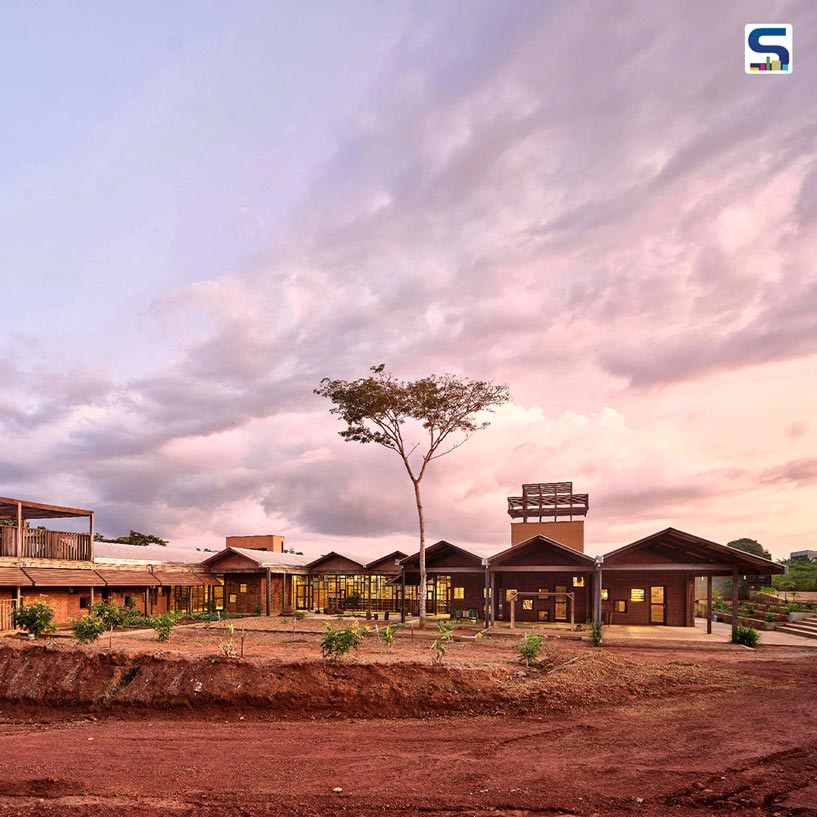
On the outskirts of Yaounde, in the town of Soa, Cameroon, a new kindergarten has redefined how architecture can nurture both education and cultural identity. Designed by the Barcelona-based practice Urbanitree, the African Flow School is a 1,600sqm project that embraces ecological building methods and local traditions, turning the school itself into a living educational tool. Learn on SURFACES REPORTER (SR) how this school challenges the conventional equation of progress with concrete by proposing a future of construction by reconnecting with ancestral knowledge, local materials and traditional methods.

The flow through the school is represented by four ecosystems, namely, mountain, savanna, village and forest, each shaping the design of specific learning spaces.
Building with Earth and tradition
Commissioned by the Missionary Daughters of the Holy Family of Nazareth, the kindergarten was envisioned not just as a functional building but as a space that reflects the mission’s distinctive flow pedagogical model. This model uses spatial design as a guide for structuring learning, creating a sequence of environments that encourage exploration, imagination and connection with nature. Urbanitree translated this philosophy into a U-shaped layout that surrounds a large communal courtyard, which turned out to be the social and symbolic heart of the school. The courtyard acts as a shared space for gatherings and play while connecting the various learning zones. More importantly, it represented the idea of flow, guiding students on a journey through different environments that mirror familiar ecosystems.

Instead, they embraced rammed-earth bricks and local hardwoods, including termite-resistant azobe, along with species such as sapele, movingui and doussie.
From the outset, the architects wanted the building itself to act as a third teacher. According to co-founder Vicente Guallart, their vision was to design a school rooted in local culture, where materials, methods and spatial experiences contribute to learning. To achieve this, Urbanitree rejected the default reliance on concrete, which in Cameroon is often seen as a symbol of progress. Instead, they embraced rammed-earth bricks and local hardwoods, including termite-resistant azobe, along with species such as sapele, movingui and doussie. For the architects, true progress lay in reviving and celebrating ancestral construction techniques that are both ecological and aligned with global sustainability goals.

This model uses spatial design as a guide for structuring learning, creating a sequence of environments that encourage exploration, imagination and connection with nature.
A sustainable learning space
The flow through the school is represented by four ecosystems, namely, mountain, savanna, village and forest, each shaping the design of specific learning spaces. At the northern end stands the mountain, a striking stacked timber structure that children can climb over or enter as a grotto, introducing both play and discovery. Moving onward, the savanna takes the form of a long, linear hall with stepped seating, providing space for group learning, while the adjacent village is embodied by a curved chapel that anchors the school’s communal spirit.

Urbanitree translated this philosophy into a U-shaped layout that surrounds a large communal courtyard, which turned out to be the social and symbolic heart of the school.
The journey culminates in the forest, where a gridded, treehouse-like timber structure invites children to climb and inhabit elevated platforms. From here, they can look out across the courtyard, gaining both perspective and joy from their surroundings. Light plays a vital role in reinforcing these ecosystem metaphors, where perforated brickwork and small clustered openings bring in light from above in the mountain, while dappled timber screens create forest-like effects in the final zone.

Designed by the Barcelona-based practice Urbanitree, the African Flow School is a 1,600sqm project that embraces ecological building methods and local traditions, turning the school itself into a living educational tool.
For Urbanitree, these design gestures are more than aesthetic choices. They allow children to develop emotional connections to the spaces. By inhabiting these environments, students engage not only with lessons but also with the traditions and landscapes of their heritage. In this way, the architecture becomes a medium for teaching values of community, sustainability and belonging. Even supporting infrastructure was carefully reconsidered. The water tower that serves the school was constructed with a lightweight timber frame rather than concrete, continuing the ecological approach. Fitted with photovoltaic panels, it provides renewable energy and helps the school manage frequent power outages.
Image credit: Adria Goula